 Pope blesses new
Pope blesses new
St. Joseph Fountain
at the Vatican
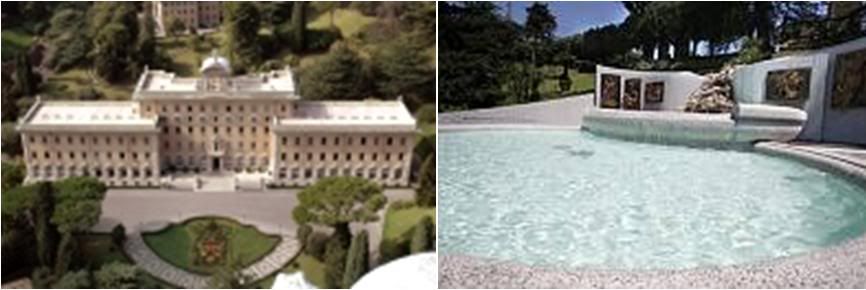 NB: Photo below right, is lifted from the PDF of the OR Page 1 and cannot be further enlarged without making the piels visible.
NB: Photo below right, is lifted from the PDF of the OR Page 1 and cannot be further enlarged without making the piels visible.
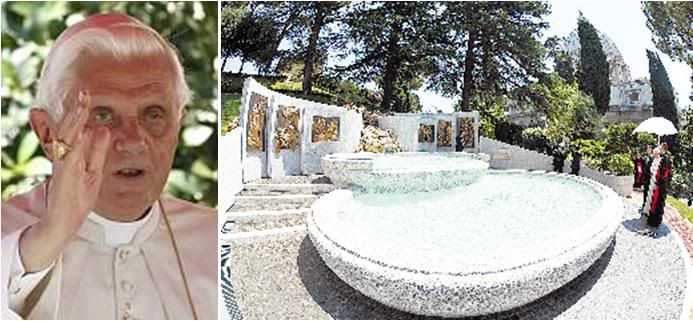
On Monday, July 5, Pope Benedict XVI blessed and inaugurated the 100th fountain within Vatican city state - a fountain named for St. Joseph and dedicated to the present Pontiff.
It is located at the edge of the green space facing the main headquarters of the Governatorate of Vatican City State, with teh apse of St. Peter's Basilica to the right of it.
The Holy Father was welcomed by Cardinal Giovanni Lajolo, Governor of Vatican City state.
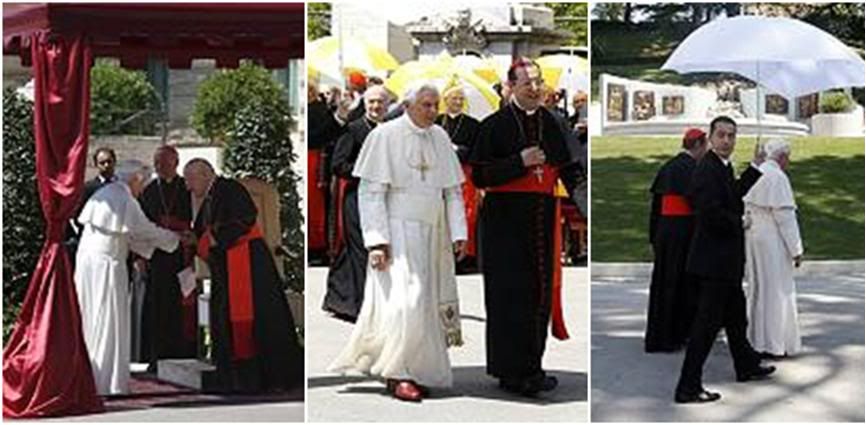
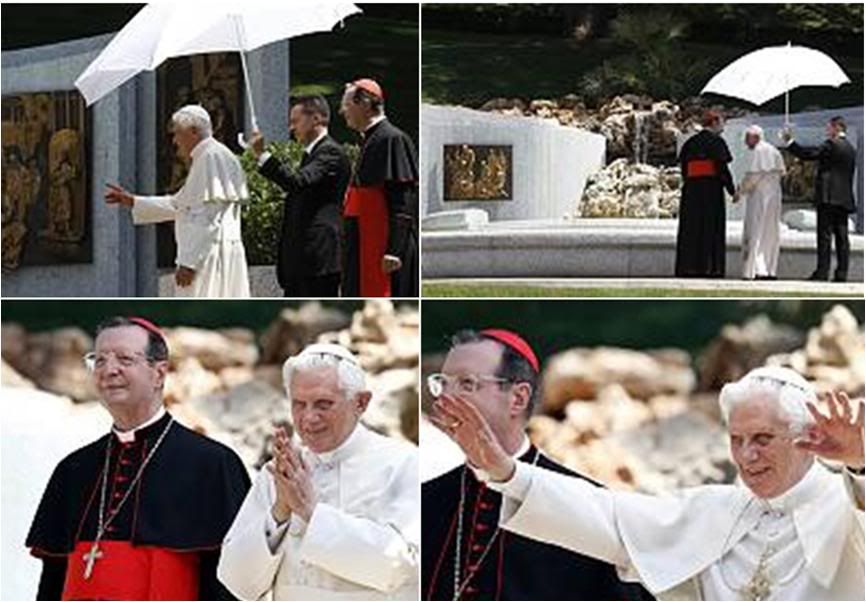
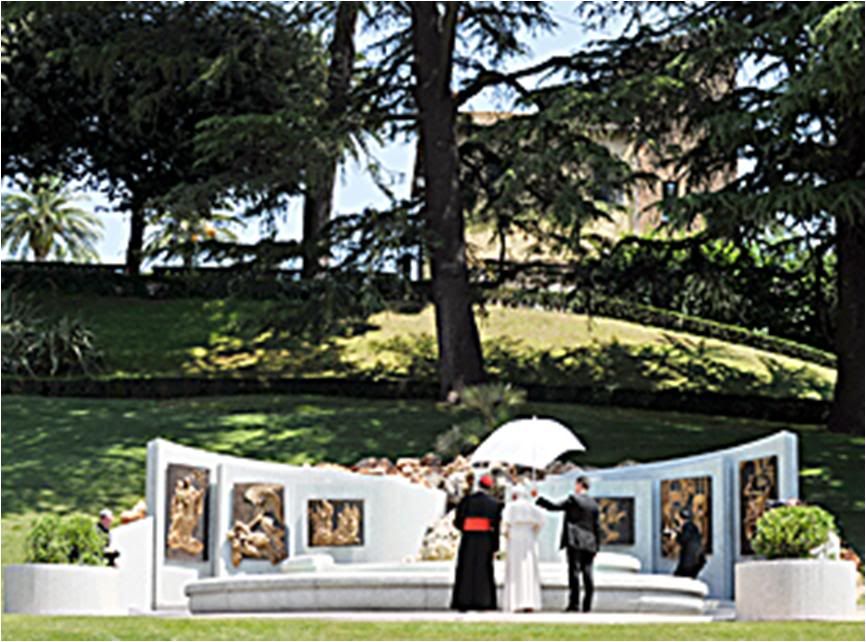

The fountain arises from a natural spring in the rocky surface of the Garden, and drains into two elliptical pools, one six meters in diameter, the other 8.
[It must be noted that many public drinking fountains around St. Peter's Square and in the city of Rome itself are fed by natural springs.]
A curved wall forms a backdrop for the fountain, and features six bronze relief panels executed by artist Franco Murer, depicting key events in the life of St. Joseph - the betrothal of Joseph and Mary, Joseph's first dream, the birth of Jesus, the flight to Egypt, 'finding' the child Jesus in the Temple, and a scene from the daily life of the Holy Family in Nazareth.
 Here is a translation of the Holy Father's remarks at the inauguration, which constitutes a most beautiful 'homily' on St. Joseph:
Here is a translation of the Holy Father's remarks at the inauguration, which constitutes a most beautiful 'homily' on St. Joseph:
Eminent Cardinals,
Venerated Brothers in the Episcopate and the Priesthood,
Distinguished Ladies and Gentlemen:
It is with joy that I inaugurate this fountain in the Vatican Gardens, a natural setting of singular beauty. It is a work that adds to the artistic patrimony of this enchanting green space within Vatican City State, a space rich with historical-artistic testimonials from various ages.
Not just the meadows, the flowers, the plants and trees found here, but also its various towers, houses, little temples, fountains, statues and other structures make the Vatican Gardens a fascinating 'unicum', a singular place.
For my predecessorts as well as for me, the Gardens have been a vital space, a place to which I gladly come frequently for prayer and serene relazation.
In addressing to each of you my heartfelt greeting, I wish to acknowledge this gift that you have offered to me and dedicated to St. Joseph. Thank you for this considerate and kind thought.
It has been an undertaking that saw the collaboration of many. I thank, above all, Cardinal Giovanni Lajolo, also for the words he addressed to me, and for his interesting presentation of the work carried out for this project.
With him, I thank Archbishop Carlo Maria Vigano and Bishop Giorgio Corbellino, secretary-egenrtal and deputy secretary-general, respectively, of the Governatorate.
Likewise, my sincere appreciation to the Vatican's Department of Technical Services; to the sculptor and project engineer, their consultants and the artisans who carried out the work; and a special thought to the spouses (Michael and Dorothy) Hintze and Robert Castrignano of London [Patrons of the Arts inscribed for the Vatican Museums], who generously financed the work, and to the Sisters of the Monastery of St. Joseph in Kyoto. And lastly, my thanks to the Province of Trento, its communes and the Trentine enterprises for their contributions.
This fountain is named for St. Joseph, a figure close to the heart of the People of God and to mine. The six bronze panels that adorn it evoke moments in his life, and I wish to dwell briefly on these.
The first panel is the betrothal of Joseph and Mary - an event which is of great importance. Joseph was from the royal lineage of David, and by his marriage to Mary, he would confirm on the Virgin's Son - the Son of God - legal entitlement as a 'son of David', in cimpliance with the prophecies.
The betrothal of Joseph and Mary was, thus, a human event which was decisive in the story of man's salvation, in realizing the promises of God. Therefore, it also has a supernatural connotation that its two protagonists accepted with humility and confidence.
The moment of testing would come soon enough for Joseph, a test that was demanding on his faith. As the promised spouse of Mary, before living with her, he found out about her coming motherhood and was very disturbed. The evangelist Matthew underscores that Joseph, being a just man, did not wish to repudiate her, but decided 'to divorce her quietly' (cfr Mt 1,19).
But in a dream - depicted in the second panel - an angel made him understand that what had happened to Mary was the work of the Holy Spirit. Joseph, trusting in God, accepted this and cooperated in the work of salvation.
Of course, divine intervention in his life could not have failed to
disturb him at heart. To entrust oneself to God does not mean seeing everything clearly according to our criteria - it does not mean achieving what we ouselves have planned.
To trust in God means to empty ourselves, renounce the self, because only he who accepts 'losing' himself for God can be 'just' as St. Joseph was, namely, one able to conform his own will to that of God and thus realize himself.
The Gospel, as we know, has not given us any statement from Joseph who carried out his work in silence. It is the style that characterized his whole existence, both before finding himself faced with the mystery of God's action on his spouse, and afterwards, when - knowing about the mystery - he was with Mary at the Nativity, represented in the third panel.
On that holy night, in Bethlehem, with Mary and the Baby Jesus, the Heavenly Father entrusted to Joseph the daily care of his Son on earth, care that he provided in humility and silence.
The fourth panel shows the dramatic episode of the flight to Egypt in order to escape the homicidal violence of Herod. Joseph was forced to leave his native land with his family, in haste - another mysterious moment in his life, another test which required of him full confidence in God's plan.
Afterwards, in the Gospels, Joseph appears in only one other episode, when he goes to Jerusalem and lives through the anguish of losing his son Jesus. St. Luke describes the effortful search for the boy and the wonder of finding him in the Temple - as the fifth panel shows - as wella as the greater wonder of hearing him say the mysterious words: "Why were you looking for me? Did you not know that I must be in my Father's house?" (Lk 2,49).
These two questions from the Son of God that help us to understand the mystery of Joseph's fatherhood. Reminding his own parents of the primacy of him whom he called 'my Father', Jesus affirms the primacy of God's will over every other, and reveals to Joseph the profound truth of his own role: He, too, is called to be a disciple of Jesus, dedicating his existence to the service of the Son of God and the Virgin Mother, in obedience to the heavenly Father.
The sixth panel represents the work of Joseph in Nazareth, alongside Jesus. The Son of God was hidden to men, and only Mary and Joseph protected his mystery and lived it every day. The Word Incarnate grew up as a man in the shadow of his parents, but at the same time, they too remained hidden in Christ, in his mystery, living out thair own vocations.
Dear brothers and sisters, this beautiful fountain dedicated to St. Joseph is a symbol for the values of simplicity and humility in the daily fulfillment of the will of God - values which distinguished the silent but precious life of the Guardian of the Redeemer.
I entrust to his intercession the hopes of the Church and the world. Together with the Virgin Mary, his spouse, may he always guide my way and yours, so that we can be joyous instruments of peace and salvation.
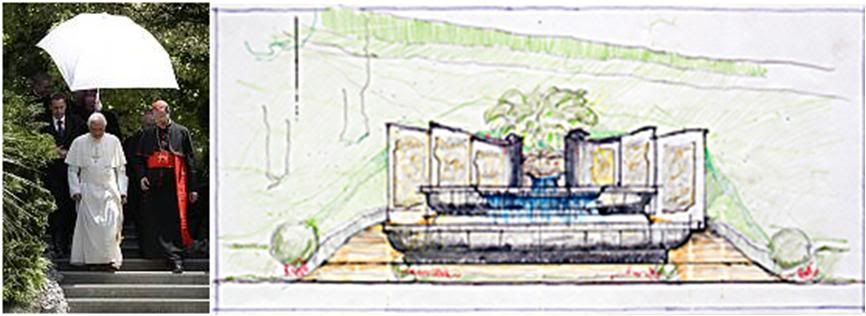 More information from a report in the July 3 OR:
More information from a report in the July 3 OR:
A travertine block inset into the pavement in front of the panels carries a Latin inscription translated thus:
To Benedict XVI, Successor of the Apostle Peter, who was given St. Joseph as his heavenly patron at baptism, (is dedicated) this fountain in honor of the spouse of the Virgin Mary, Mother of God, guardian of the Holy Family, protector of the universal Church and patron of workers. The 100th fountain in Vatican City is offered as a gift through the generosity above all of Patrons of the Arts of the Vatican Museums. July 5, in the year of the Lord 2010, the sixth of this Pontificate.
Franco Murer, who designed and executed the bronze panels, is a sculptor from Belluno, who previously designed two commemorative medallions for John Paul I and the stations of the Cross in bronze for a church in Canale d'Agordo, John Paul I's hometown near Belluno.
Murer won the competition for the fountain design over four other atists who were chosen on the basis of their work and professional career.
A palm tree has been planted in the space between the two panels as a symbol of the Holy Land.
The Vatican's department of technical services is marking the inauguration of the new fountain by publishing 3 volumes on the Fountains of Vatican City - the first on the Fountains along the Roadways and in the Woodland; the second on Fountains in Buildings and Monuments, and the third on the Fountains in St. Peter's Square and in the Vatican Gardens - to promote knowledge about the artistic and cultural patrimony represented by these special monuments.
[Modificato da TERESA BENEDETTA 06/07/2010 22:15]